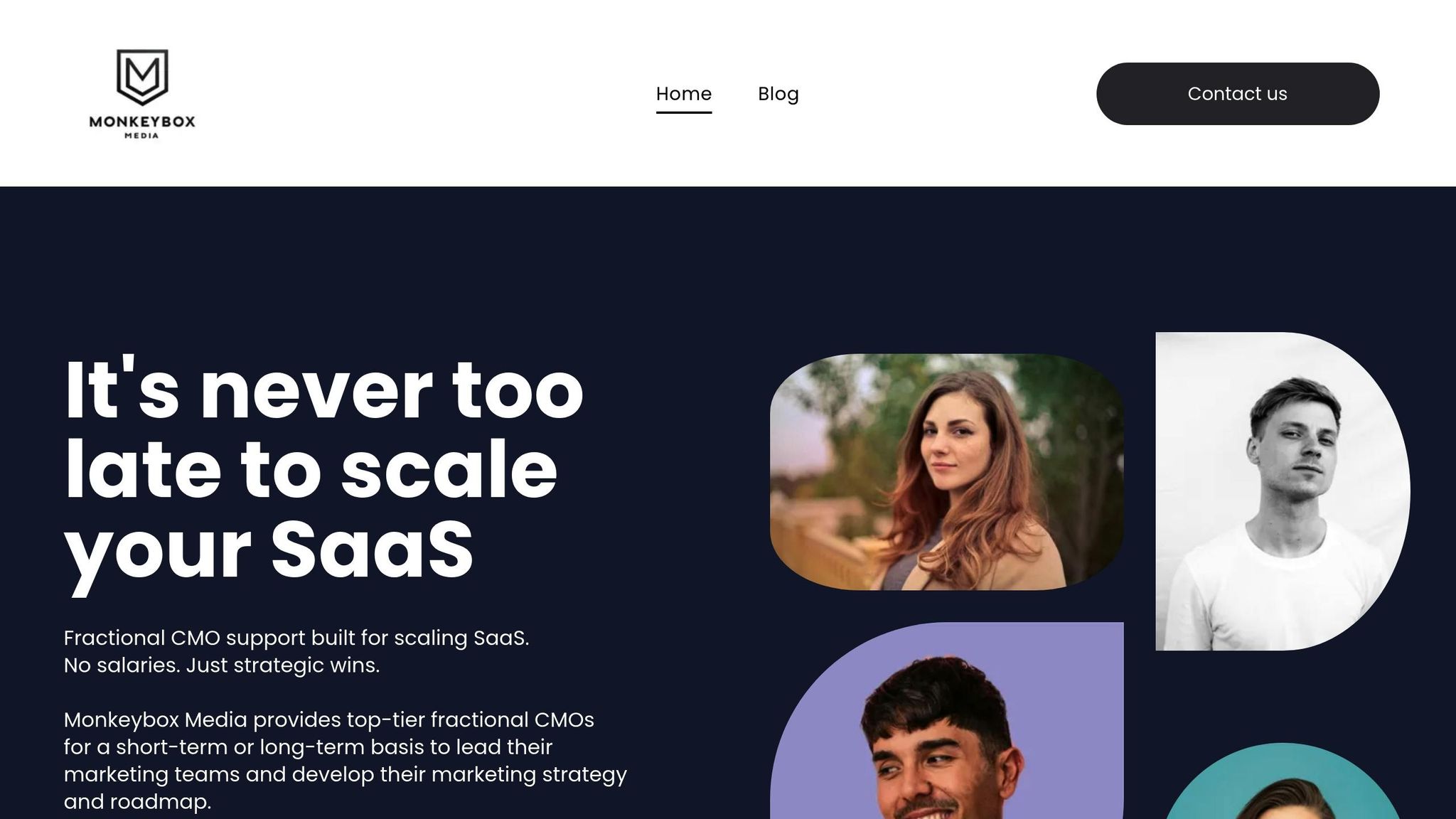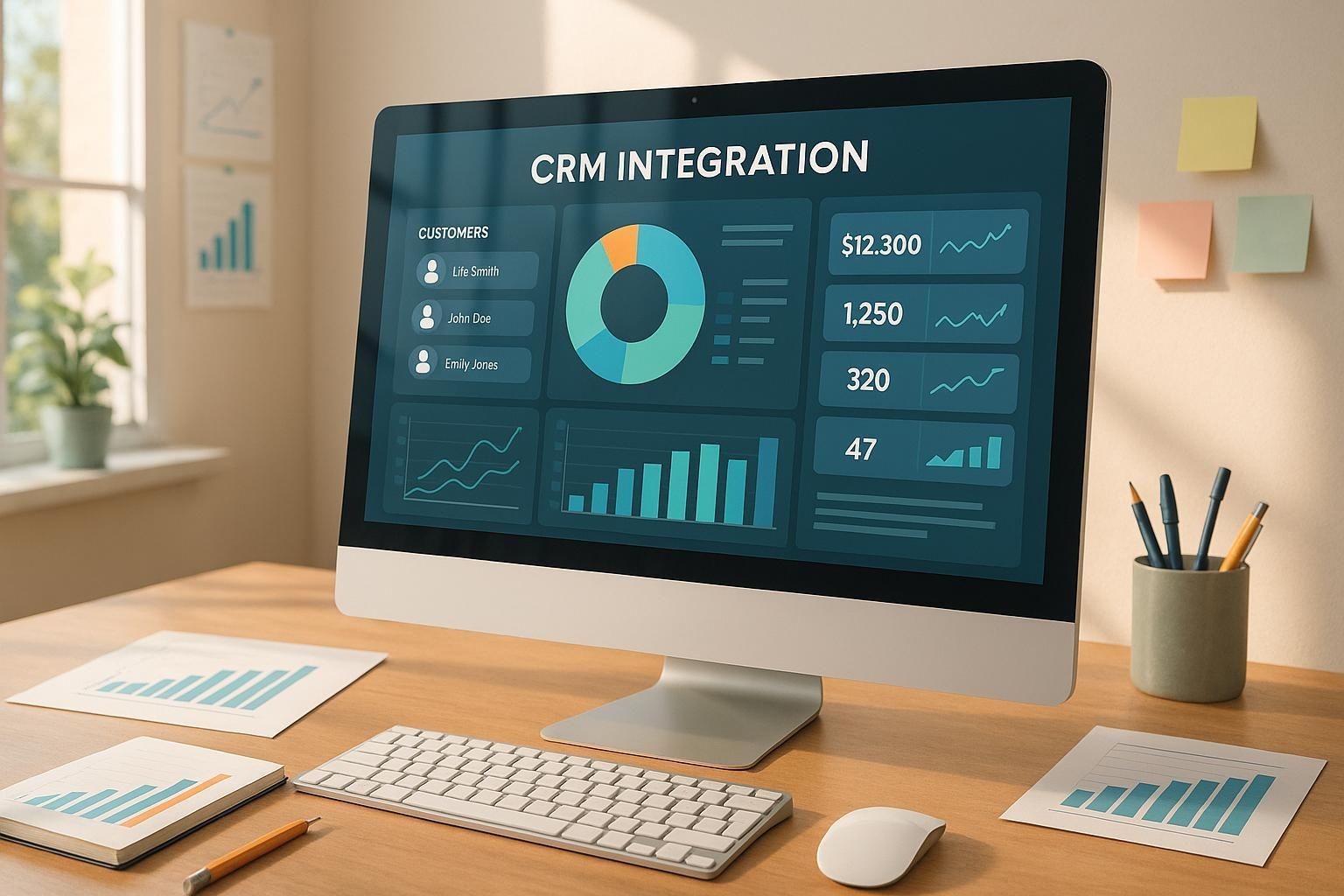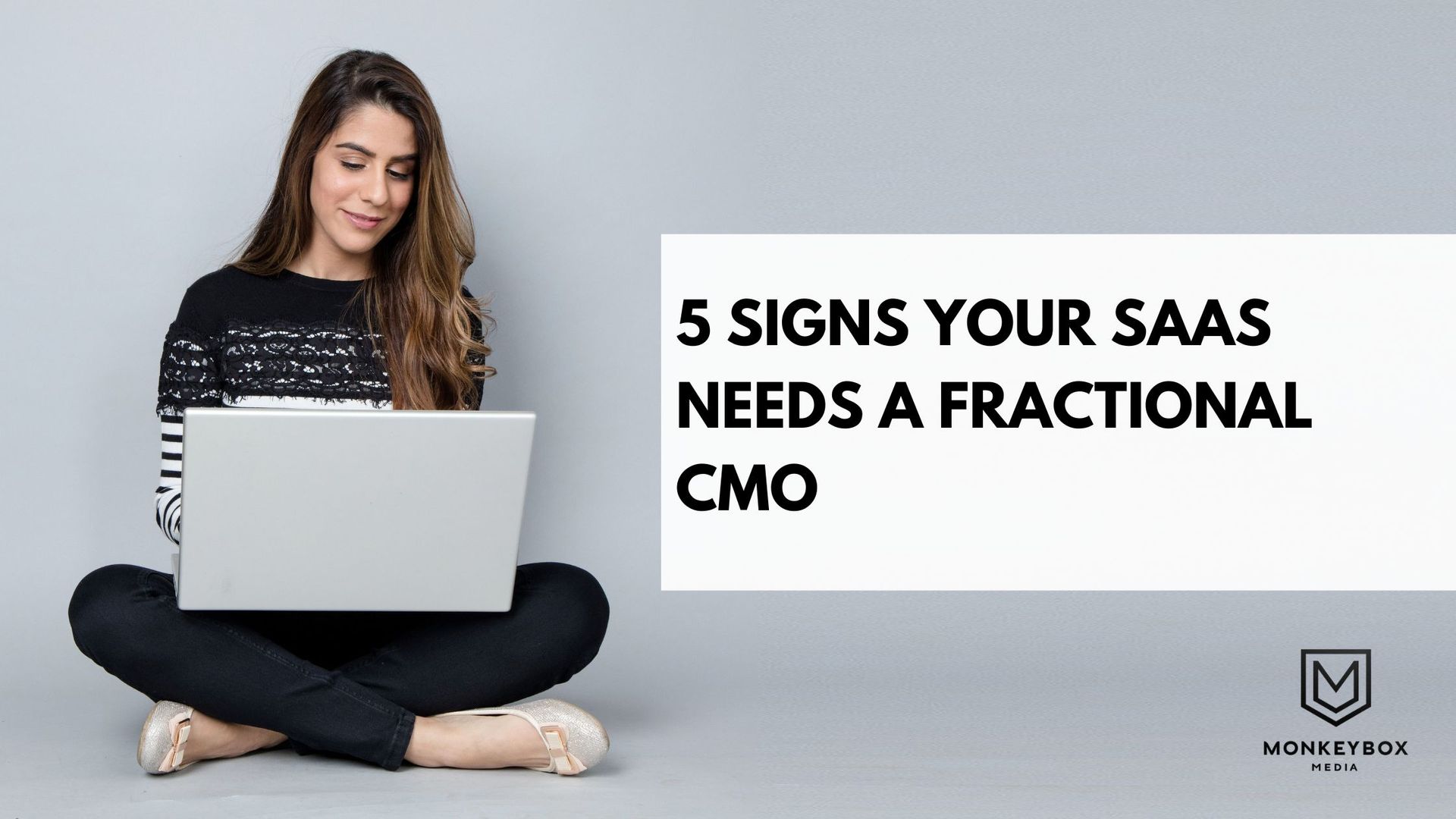Fractional CMO Insights: Data-Driven SaaS Leadership
Fractional CMOs are reshaping SaaS growth by offering senior marketing expertise on a flexible, part-time basis. Here's why they matter:
- Cost-effective leadership : Avoid the high salary and long-term commitment of a full-time CMO.
- Data-driven strategies : They focus on metrics like CAC (Customer Acquisition Cost), LTV (Lifetime Value), and churn to guide decisions.
- Quick impact : Fractional CMOs integrate fast, bringing proven strategies to address challenges like weak pipelines, unclear messaging, or high churn.
- Tool optimization : They unify systems (e.g., HubSpot , Salesforce , Mixpanel ) for actionable insights and better decision-making.
For SaaS founders, a fractional CMO offers immediate expertise to scale efficiently, refine marketing strategies, and align teams around measurable goals. This approach ensures every marketing dollar drives growth.
Key SaaS Metrics Every Fractional CMO Monitors
Fractional CMOs know that SaaS growth isn’t about chasing vanity metrics like website traffic or social media followers. Instead, they focus on metrics that directly affect revenue and long-term growth. Every marketing dollar needs to show measurable results. Here’s a closer look at the metrics that truly matter.
Core Metrics for SaaS Success
Monthly Recurring Revenue (MRR) and Annual Recurring Revenue (ARR) are the bedrock of any SaaS business. These metrics offer a snapshot of predictable income and growth trends. Fractional CMOs track MRR growth month-over-month to spot patterns that guide decisions on campaign timing and budget allocation.
Customer Acquisition Cost (CAC) is another essential metric, capturing the total expense of acquiring a new customer. This includes costs from marketing, sales, and operational overhead. It’s a critical measure for determining which acquisition channels deliver the best value.
Customer Lifetime Value (LTV) estimates the total revenue a customer will bring over their relationship with the company. For example, a customer spending $100 per month with a 2% churn rate generates an LTV of $5,000 over 50 months. Factoring in a 7% annual discount rate, that figure adjusts to about $3,793.55 over 38 months.
The LTV to CAC ratio is a key indicator of profitability. According to Kalungi :
Successful SaaS businesses rely on key metrics like customer acquisition cost (CAC) and customer lifetime value (LTV). These SaaS metrics help you track progress and make informed decisions
. A ratio of 1:1 suggests acquisition costs equal the revenue a customer generates, while a 3:1 ratio is often seen as ideal. If the ratio exceeds 5:1, it may indicate an opportunity to invest more in customer acquisition.
Churn rate measures how many customers cancel their subscriptions during a specific period. High churn rates can lower LTV and signal problems with customer satisfaction or product-market fit that need immediate attention.
How Metrics Shape Marketing Strategy
Metrics like these aren’t just numbers - they’re the foundation of a well-rounded marketing strategy. Fractional CMOs use them to align marketing efforts with broader business goals. By digging into data from marketing campaigns, sales funnels, and acquisition costs, they identify inefficiencies and uncover growth opportunities.
Sergiy Solonenko, Founder of Algocentric Digital Consultancy , emphasizes the importance of this approach:
Their approach is centered on data-informed decision making
. This focus on data drives the use of analytics tools and tracking systems that provide real-time insights. These tools enable quick adjustments, such as running A/B tests on landing pages, refining email campaigns, or tweaking targeted ads.
How Metrics Impact Growth Decisions
Metrics also play a vital role in shaping growth strategies. Companies that prioritize tracking key metrics can quickly identify profitable channels, adjust budgets, and address challenges like customer churn before they escalate. Ignoring these insights and relying solely on gut feelings can delay critical decisions.
When metrics reveal inefficiencies - like low retention rates or high acquisition costs - Fractional CMOs can take targeted actions. This data-driven approach ensures steady growth and better allocation of resources .
Building a Data-Driven Marketing Culture
Shifting to a marketing culture where decisions are driven by data requires a change in mindset and collaboration across teams. Fractional CMOs are particularly skilled at guiding this transformation, thanks to their fresh perspectives and proven methods for breaking down departmental silos.
Getting Teams to Work Together with Data
In many SaaS companies, teams often operate in isolation, each relying on its own metrics. Marketing may focus on lead generation, sales tracks conversion rates, and product teams monitor user engagement. Without alignment, these departments can unintentionally work against each other.
Fractional CMOs address this by creating shared dashboards that tie together metrics across departments, such as linking lead generation to user activation. This transparency helps eliminate the blame game when growth slows.
The secret lies in selecting metrics that matter to everyone. Take time to value , for instance - how quickly new customers achieve their first success with the product. This metric impacts marketing strategies, sales onboarding processes, and product development. When all teams track it together, collaboration becomes a natural outcome as they work to improve the same goal.
Cross-functional meetings also become more productive when everyone speaks a common "data language." Marketing can demonstrate how campaigns affect lead quality, sales can share insights on messaging that resonates during demos, and product teams can illustrate how feature updates influence user activation. This unified approach creates a solid foundation for scaling operations.
Growing SaaS Marketing Operations
Scaling marketing efforts isn't just about hiring more people - it's about building systems that can handle complexity as the business grows. Fractional CMOs bring experience from various companies and know which processes work at different stages of growth.
They implement standardized processes, such as documenting campaign workflows, lead scoring, and performance analysis, making scaling smoother. They also use scalable automation to tackle operational bottlenecks, ensuring systems remain efficient.
Fractional CMOs prioritize knowledge transfer by ensuring teams understand the importance of metrics and how to use new tools effectively. This preparation helps prevent the chaos that often accompanies rapid growth.
Steps to Make Data Part of Every Decision
Once teams are aligned and operations are running smoothly, the next step is embedding data into every decision to create a culture of accountability. Successful fractional CMOs often start small, showcasing the value of data-driven decisions through quick wins, and gradually expand this approach across all marketing activities.
Here’s how to make data central to decision-making:
- Start with weekly data reviews : Encourage team members to present one insight from their work and explain how it could influence future decisions. This practice turns data analysis into a regular habit rather than an occasional task.
- Test assumptions with data : If someone believes a particular marketing channel is the best for customer acquisition, run experiments to validate or challenge that belief. This reduces reliance on gut feelings and builds trust in data-backed conclusions.
- Simplify data access : Create dashboards that are easy for non-technical team members to understand. Intimidating analytics tools can discourage exploration, but clear visualizations make it easier for everyone to see how their work impacts key metrics, driving greater engagement.
Resistance to change is natural, especially when people fear that data-driven approaches might limit creativity or undervalue their experience. Fractional CMOs counter this by showing how data enhances creativity, revealing which ideas resonate with audiences and which don’t.
The goal isn't to replace human intuition with spreadsheets - it’s about equipping teams with better information to make smarter decisions. When marketers see how data improves campaigns and drives better outcomes, they’re more likely to embrace this approach. These strategies empower SaaS marketing teams to act quickly on insights and maintain growth over time.
Tools and Systems for Data-Driven SaaS Leadership
Having the right tech stack in place is essential for effective, data-driven marketing. However, fractional CMOs often step into organizations with scattered systems - marketing data in one tool, sales metrics in another, and customer success data somewhere else. Their expertise lies in selecting and connecting the right tools to provide a unified view of the customer journey. This integrated approach helps them uncover actionable insights and implement agile marketing strategies.
Best Tools for SaaS Analytics and Reporting
SaaS companies rely on a variety of platforms to manage everything from tracking website visitors to calculating customer lifetime value. Here’s a closer look at some of the most commonly used tools:
- HubSpot : A favorite among mid-market SaaS businesses, HubSpot offers an all-in-one solution with CRM, automation, and reporting. It tracks leads from their first website visit to closed deals, making customer acquisition cost calculations straightforward.
- Salesforce + Pardot : This combination is ideal for larger SaaS companies that need advanced customization. It supports complex lead scoring and intricate sales processes involving multiple decision-makers. However, the setup can be challenging, often requiring dedicated resources.
- Mixpanel and Amplitude : These tools specialize in product analytics, helping teams understand user behavior. They provide insights into feature adoption, engagement, and churn, which fractional CMOs use to shape marketing strategies and highlight the features that drive satisfaction.
- Google Analytics 4 and Hotjar : While Google Analytics 4 delivers essential website performance data, Hotjar takes it further with heatmaps and session recordings. This helps SaaS companies see how visitors interact with pricing pages, signup flows, and product demos.
- ChartMogul and ProfitWell : For financial reporting, these tools are indispensable. They calculate SaaS-specific metrics like monthly recurring revenue (MRR), annual recurring revenue (ARR), and customer lifetime value. Integration with billing systems like Stripe or Chargebee ensures real-time revenue insights.
Connecting Data Tools Across Teams
Once the right tools are identified, integrating them becomes critical for smooth operations. Here’s how teams can connect their data:
- Zapier : Perfect for basic integrations, Zapier automates tasks like transferring lead data from marketing platforms to CRM systems.
- Segment : Acting as a customer data platform, Segment collects data from multiple sources and distributes it to analytics and marketing tools.
- Slack : With integrations, Slack can send real-time alerts to sales and customer success teams. For example, sales teams can be notified when a marketing-qualified lead reaches a specific engagement level, or customer success teams can be alerted when usage patterns suggest potential churn.
For scaling companies, data warehouses like Snowflake or BigQuery become essential. These platforms consolidate data from all business systems, enabling complex, cross-departmental analysis. Tools like Tableau and Looker then transform this raw data into visually engaging dashboards, making it easier for fractional CMOs to demonstrate marketing ROI and secure budget approvals.
Popular SaaS Analytics Tools Compared
| Tool | Ideal For | Monthly Cost | Key Strengths | Limitations |
|---|---|---|---|---|
| HubSpot | Mid-market all-in-one | $800-$3,200 | Easy setup, integrated CRM | Limited customization |
| Salesforce + Pardot | Enterprise sales/marketing | $2,000-$5,000+ | Highly customizable | Complex implementation |
| Mixpanel | Product analytics | $89-$833 | User behavior tracking | Steep learning curve |
| ChartMogul | SaaS metrics | $100-$500 | Revenue analytics | Limited marketing features |
| Segment | Data integration | $120-$1,200 | Clean data collection | Requires technical setup |
Scaling Tools with Growth
Choosing the right tools means finding a balance between current needs and future growth. A SaaS company with $2 million in ARR doesn’t need the same complex analytics stack as one with $50 million in ARR. Fractional CMOs are skilled at matching tools to a company’s stage of growth, avoiding the pitfalls of overcomplicated systems that waste time and resources.
The best approach? Start small with one or two essential platforms, then add complementary tools as the company grows. This avoids overwhelming teams with too many dashboards and ensures the focus remains on actionable insights. By building an integrated toolset step by step, SaaS companies can set the stage for scalable and efficient marketing operations.
sbb-itb-6e0f5a2
Why Fractional CMOs Work Well for SaaS Growth
Hiring a full-time Chief Marketing Officer (CMO) can be both expensive and time-consuming for growing SaaS companies. Fractional CMOs offer a practical alternative by providing senior-level marketing expertise on a part-time or contract basis, making them a smart choice for businesses looking to scale effectively without the hefty price tag.
Benefits of Fractional CMO Leadership
Immediate Strategic Impact
Fractional CMOs bring years of experience to the table, allowing them to integrate into a company quickly and start identifying opportunities right away. They focus on implementing proven strategies that deliver measurable results in a shorter time frame.
Cost-Effectiveness
Rather than committing to the high salary and benefits of a full-time executive, companies can tap into top-tier marketing leadership at a fraction of the cost. This flexible approach makes it easier for SaaS businesses to allocate resources where they’re needed most.
Broad Industry Experience
With experience spanning various SaaS verticals, fractional CMOs bring fresh perspectives and creative strategies to the table. Their exposure to different markets often leads to ideas and solutions that may not emerge from internal teams.
Adaptable Engagement Models
One of the key advantages of a fractional CMO is flexibility. Whether you need extra support during a product launch or want to scale back during quieter periods, their engagement can be tailored to your current needs and budget. This adaptability ensures alignment with your business goals at every stage.
How Fractional CMOs Solve Common SaaS Challenges
Refining Positioning
Many SaaS companies struggle with messaging that doesn’t connect with their target audience. Fractional CMOs help refine this by reworking value propositions, clarifying target demographics, and ensuring that messaging resonates across all platforms, from sales decks to marketing campaigns.
Fixing Pipeline Issues
A weak sales pipeline can cripple growth. Fractional CMOs conduct in-depth audits of the sales process to identify bottlenecks and inefficiencies. They then develop targeted content strategies and lead generation systems that focus on high-impact channels, ensuring a steady flow of qualified leads.
Reducing Customer Churn
Retention is just as important as acquisition. Fractional CMOs work to redesign onboarding processes and align marketing with customer success efforts. By creating lifecycle campaigns that keep users engaged, they help reduce churn and maintain customer satisfaction.
Clarifying Messaging
Technical jargon can often alienate potential customers. Fractional CMOs excel at simplifying complex ideas into clear, engaging language. This not only improves ad and email performance but also makes it easier for audiences to understand and connect with your product.
Strengthening Team Leadership
Fractional CMOs don’t just focus on strategy - they also mentor and guide internal teams. By setting clear goals and aligning efforts across departments, they help energize teams and create a unified approach to marketing initiatives.
Fractional CMOs vs. Full-Time CMOs: A Comparison
| Factor | Fractional CMO | Full-Time CMO |
|---|---|---|
| Cost | Flexible, lower fixed costs | Higher fixed costs with salary and benefits |
| Time to Impact | Quick integration, faster results | Longer adjustment period |
| Experience | Insights from diverse industries | Deep familiarity with one company |
| Flexibility | Scales with business needs | Fixed, long-term commitment |
| Risk | Lower risk due to short-term contracts | Higher risk with long-term commitments |
| Best Fit | Growing SaaS companies needing adaptable leadership | Larger companies with ample resources |
This side-by-side comparison highlights why fractional CMOs are particularly well-suited for growing SaaS companies. They offer a low-risk way to access executive-level marketing expertise while maintaining flexibility and cost efficiency.
De-Risking Executive Hires
One of the biggest advantages of hiring a fractional CMO is the ability to "test the waters" before committing to a full-time executive. Companies can evaluate whether the CMO is the right fit - both strategically and culturally - without the pressure of a long-term contract.
Fractional CMOs also rely heavily on data to guide their decisions. By monitoring metrics like customer acquisition costs, churn rates, and lifetime value, they ensure every campaign is optimized for maximum return on investment. This data-driven approach makes them an invaluable resource for SaaS companies that prioritize measurable growth and strategic decision-making.
Conclusion: Growing SaaS Through Data-Driven Leadership
SaaS companies thrive when they combine smart leadership with data-driven decision-making. Those that rely on measurable insights consistently outperform their competitors.
Key Insights from Fractional CMO Experts
- Data drives decisions: Metrics like CAC (Customer Acquisition Cost) and MRR (Monthly Recurring Revenue) are essential for steering growth. Without tracking these, even the most creative campaigns risk becoming costly experiments.
- Integrated tools matter: Successful SaaS companies connect their platforms to create a clear, unified view of the customer journey. This helps them make informed decisions quickly and adjust strategies in real time.
- Culture over technology: A strong data-driven culture empowers teams to challenge assumptions, test ideas, and base strategies on evidence rather than gut feelings.
- Adaptability wins: In the fast-paced SaaS world, companies that can quickly pivot using data insights gain a clear edge over slower competitors.
These principles highlight the value of fractional leadership, a service that Monkeybox Media specializes in delivering.
How Monkeybox Media Fuels SaaS Growth

Monkeybox Media offers fractional CMO services tailored to help SaaS companies overcome growth challenges. Here's how they make a difference:
- Strategic marketing leadership: They design data-driven frameworks to meet specific goals, whether it's reducing churn, boosting conversion rates, or entering new markets.
- Team training and alignment: Monkeybox Media equips your marketing team with the skills to implement and refine strategies independently, ensuring long-term benefits.
- Streamlined systems: By addressing technical barriers, they ensure your data is accessible and actionable. Their part-time CTO services complement marketing efforts by optimizing your tech stack to support growth.
With flexible engagement terms, Monkeybox Media’s services adapt to your company’s growth stage without the financial strain of full-time executive hires.
What SaaS Founders Should Do Next
To stay competitive, SaaS founders need to take action now:
- Audit your data infrastructure: Ensure you’re tracking critical metrics like CAC, LTV (Lifetime Value), and churn rates. Align sales and marketing teams around these key indicators.
- Assess your team’s data skills: Analytics tools are only as effective as the people using them. Determine if your current team has the expertise to build a data-focused culture.
- Explore the fractional CMO model: If your company is scaling quickly, facing complex marketing challenges, or unsure about hiring a full-time executive, a fractional CMO offers a flexible and cost-effective solution.
Data-driven leadership isn’t about perfection - it’s about making smarter decisions with the information you have. SaaS companies that embrace this mindset, supported by experienced fractional leaders when needed, set themselves up for measurable, sustainable growth in today’s competitive market.
FAQs
How does a fractional CMO work with existing teams, and how do they influence company culture?
A fractional CMO works hand-in-hand with existing teams, diving into their workflows, understanding their challenges, and aligning with their goals. They make it a priority to get familiar with the company’s values and overall vision. By maintaining open lines of communication and actively engaging with team members, they build trust and create a sense of collaboration.
Their influence on company culture tends to be positive. With fresh ideas and strategies backed by data, they inspire innovation and teamwork. While their part-time status might limit complete integration, their emphasis on alignment and flexibility allows them to play a meaningful role in the company’s growth and cultural development.
How do fractional CMOs help SaaS companies reduce customer churn?
Fractional CMOs are essential for SaaS companies looking to tackle customer churn. They bring data-driven strategies to the table, aimed at improving customer retention and satisfaction. One key focus is creating personalized onboarding experiences , ensuring new users quickly grasp the value of the product. They also design engagement campaigns to keep users actively involved and happy with their experience.
By diving into customer behavior and feedback, fractional CMOs can pinpoint users who might be at risk of leaving. From there, they craft targeted retention programs to address specific challenges. On top of that, they introduce upselling strategies that align with what customers actually need, building trust and encouraging long-term loyalty. These efforts not only reduce churn but also set the stage for steady, sustainable growth.
How can SaaS companies know if hiring a fractional CMO is the right choice?
Why SaaS Companies Should Consider a Fractional CMO
If your SaaS company is dealing with stalled growth, a lack of clear marketing direction, or misalignment within your team, it might be time to think about bringing in a fractional Chief Marketing Officer (CMO). This option is especially useful when you need top-tier marketing leadership but aren’t ready to commit to the cost or permanence of hiring someone full-time.
Some common signs that a fractional CMO could benefit your business include:
- Difficulty turning marketing data into actionable strategies.
- A need to streamline and improve your marketing operations.
- A lack of specialized expertise in SaaS marketing strategies.
By stepping in with both strategic guidance and practical support, a fractional CMO can help drive growth, boost ROI, and ensure your team is working toward the same goals. It’s a smart way to get expert leadership without the full-time commitment.








